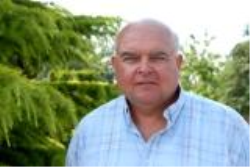
Quit breaking cows top American nutritionist tells UK herd managers 23rd August 2006.doc>> erds to optimise productivity and production costs, Dr Blaine Ellison - one of America's leading independent nutritionists - told forward-thinking managers of large dairy herds attending the 'Meeting the Challenges' seminar, held recently in Cheshire. Organised by nutrition specialists Lillico Attlee, the Evidence Based Veterinary Consultancy (EBVC), Cephaguard and Farm Business Magazine the seminar, which was attended by managers with collective responsibility for more than 11,500 dairy cows, focused on the nutritional and veterinary aspects of managing a large herd in today's tough agribusiness environment.
Dr Ellison, who is responsible for feeding more than 50,000 cows and heifers in America, including one 10,000-cow dairy herd in Florida, pointed out that dry cow nutrition holds the key to the large herd profitability and offers a multiple payback on investment. It starts in the far-off period and if dry cows are too thin then overall production will suffer, the shape of the herd lactation curve will be abnormal, reproduction will decline and cows will milk or breed from body protein and lipid reserves. Modifying Body Condition Score by just 0.25 points takes around 60 days, Dr Ellison emphasised, so there's little point in standing in the dry cow lot when the problem is to be found in late lactation cows. Producers should therefore stop 'breaking cows' during lactation and instead focus on salvaging the next group of dry cows.
The biggest asset for producers, said Dr Ellison, is a herd of healthy, properly conditioned, pregnant cows that respond to management like healthy cows should. The biological momentum required to build or tear down this condition is a herd's biggest asset or hurdle and to deny this is dangerous to the site's financial stability. However, Dr Ellison pointed out that any dairy with comfortable, healthy, well-fed, pregnant cows can remain in business and be profitable.
Reminding delegates that a cow can't eat more the day after calving than the day before, Dr Ellison pointed out that it takes a full year to put right the impact of 'breaking' her at this stage. He also highlighted that a heifer makes 3kg/day more milk at 80% stocking density than at 100% and 2kg more milk/day when housed with other heifers rather than mature cows.
Highlighting new developments in dry cow management, Dr Ellison said studies have highlighted the need to reduce cattle movements between sites/groups, reduce stocking pressure to minimise social stresses, limit the number of rations fed to limit nutritional stress and focus management on a single group at a time. Good candidates to benefit from improved dry cow management are herds with adequate body score in late lactation, a normal incidence of twinning, that are predominantly AI bred and have the recording capacity to track the number of days that cows spend in the close-up group.
Summing up, Dr Ellison highlighted the need for accurate breeding and pregnancy data to ensure the proper number of days dry, to reconfirm pregnancy at dry-off, to manage body condition score (BCS) during the last 150 days of lactation and to implement a herd-specific vaccination programme at dry-off. Herd managers must also recognise the need to formulate far-off and close-up rations from current forage tests to maintain BCS within +/- 0.25. They must also move any healthy cow found to be thin into the close-up group because of the high probability of twins and formulate an appropriate DCAD in the close-up ration for the final 21 - 25 days.
BEST, NOT CHEAPEST
Correct nutrition is all about achieving best nutrition, not cheapest nutrition, which means feeding for optimum cow health, performance and financial returns, not saving money emphasised Warwick Bastard, a Ruminant Nutritionist with Lillico-Attlee.
In a presentation entitled Managing Nutrition for Productivity and Fertility, he pointed out that because a cow eats maintenance regardless of production feed efficiency must be measured in litres/kg drymatter intake and large herds in particular must therefore consider total feed cost. Whilst acknowledging that obtaining sufficient forages can be a challenge on many farms, Mr Bastard highlighted that the use of forage replacement products may cheapen the diet and total income per cow is therefore the important measure, not the widely used 'margin over concentrates'.
Emphasising that there's no one right way to formulate a diet, Mr Bastard underlined the fact that nutrition holds the key to achieving and maintaining performance from a high output dairy herd. Demanding specialist knowledge and continual appraisal, it is one element of managing a large herd that cannot be ignored.
In a paper entitled Monitoring Herd Nutrition, Richard Vecqueray MRCVS of the EBVC explained that feeding high-yielding dairy cows successfully is fundamentally about walking a knife edge between acidosis and energy deficiency. Managing a large dairy herd he likened to piloting an oil tanker along the Alaskan coast - both possess a critical momentum that makes them difficult to turn around quickly enough to miss looming icebergs unless they're noticed and avoided well in advance. Whilst most nutritionists, vets and dairy farmers possess the monitoring tools to safely navigate through lactation, Mr Vecqueray said they often fail to use them regularly enough to be useful.
Other presentations at the 'Meeting the Challenges' seminar included The use of fats in large herd nutrition by Dr Roland Adelmann, Head of Technical Services and Product Development for Berg & Schmidt Lipids, while Dr Desmond Rice discussed Managing acidosis in the large herd. Mike Christie MRCVS spoke on Targeting heat detection and James Husband MRCVS discussed Records and record analysis.
Further information is available from Lillico Attlee, The Forstal, Beddow Way, Aylesford, Kent, ME20 7BT. Tel: 01622 718062.
